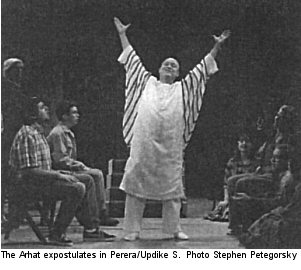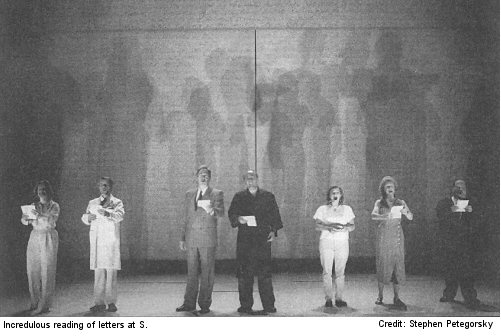Updike-Based Opera "S." Bows in Massachusetts

In what was billed as "a fully staged workshop," Smith College presented (September 1995) the first production of Ronald Perera's two-act opera, "S.", based on the novel by John Updike. The comic music theatre work was created by the same team that had collaborated on The Yellow Wallpaper, also first produced at the Northampton, Massachusetts college where Perera has been on the music faculty since 1971: apart from Perera, who supplied the music, Constance Congdon shaped the impertinently hilarious Updike novel into a libretto; and Mark Harrison was responsible for the original conception and stage direction. Paul Flight conducted the ensemble for this chamber version, consisting of two pianos, synthesizer, and percussion (Perera will be scoring the work for full, though hardly conventional, orchestra—it will include an Indian sub-ensemble of sitar, tambura and tabla—for its first full-scale production.) The opera calls for a complement of 13 singers and chorus, and the excellent Smith College cast included Jane Bryden (as Sarah Worth), James Maddalena (as Charles Worth), Douglas Perry (as The Arhat), Susan Trout (an effective last-minute stand-in as Durga) and Karen Smith Emerson (as Alinga).
Updike's 32nd book is an epistolary novel telling the tale of a New England matron, Sarah Worth (who signs all her letters simply "S."), whose life-change takes her to a Buddhist-style "ashram" (commune) in Arizona, there to meet a band of characters (in both senses) that contrast wildly with the socially and economically prominent milieu she has abandoned. While the dénouement in both book and opera is surprising—much in the way of some Rossini or Gilbert and Sullivan plots—there is a serious element inherent in the Congdon portrayal of the protagonist that emerges only after the final curtain. We have been so doubled up with laughter that we only gradually become aware of the substantive change that has gone on in Sarah before our eyes, a maturation from a flaky, self-indulgent faddist facing her midlife crisis to a sober, still comfortable survivor, now able to subsist in solitude.
The Perera-Congdon-Harrison team had been working on "S." for a couple of years before its completion. In November 1994, a reading (without music) was given at the New Dramatists in New York which revealed the nature of the work's characters, giving those who would later be involved with the musical production an opportunity to meet and identify with those personalities, and also permitting the creative squad a chance to hone and refine. In the program book, Perera reminisces: "How could you possibly turn "S." into an opera?" is the question I am invariably asked by friends who have read John Updike's 1988 novel. Indeed when Mark Harrison first suggested the idea to Connie Congdon and me in about 1992, the prospect engendered as much skepticism as enthusiasm. Here was an epistolary novel told from the point of view of a single character, a novel grounded in satire and irony—qualities which do not leap to mind as musical—and moreover a novel that delights in language so intricate and compelling you don't want to miss a word. On the other hand, here was a very funny book about one contemporary American woman's spiritual odyssey by one of America's greatest living authors, a work that itself referred back to an American classic The Scarlet Letter, and a story with a strong narrative arc. Additionally it was a work that called for lots of ensembles, split scenes and the inclusion of non-western musical elements, and that evoked a milieu that all the collaborators felt they understood. Not least, John Updike and his publisher seemed quite taken with the idea."
 The genesis of the opera was more complex than most, involving the creation of text—the book, of course, had almost exclusively on person's narrative; the abridgement of time and telescoping of events; and the difficult question of language. "How was one to deal," Perera recalls, "with sentences that sometimes ran into a paragraph or that deployed strings of difficult words, including Sanskrit?! Connie's aim was to preserve the cadence of Updike's language just as far as possible; mine was to make all the sung text intelligible." At the Smith performances, a Sanskrit glossary was distributed with the program, the amusement as well as edification of the audience.
Fascinating as the textual dimension of "S." may be, the ultimate question about any opera must concern the music. The general consensus revealed great enthusiasm for Perera's ability to evoke so vast a palette. Western and eastern motifs melded into one another, contrasting but never clashing. Characters and situations were clearly distinguishable through the music, solo set pieces led into ensembles, lyrical passages gave way to sections of wild buffoonery. There are hilarious sequences for Charles and his lawyer in both acts, a love duet ("Klishta and maya. Let's not do the books tonight") for two women, a wooing scene ("The Dances of Shiva and Shakti") for the Arhat and Sarah that nods fondly to Borodin's exoticism, production numbers for the chorus ("Physical labor"), and haunting inner monologues ("I close my eyes")—all of which had the audience humming at act closings. It is clearly a score that people can enjoy and remember.
"Judging from the extremely warm reception given by a capacity audience to the performance I heard on Saturday," wrote Everett Hafner in The Valley Advocate, "one can say without question that "S." met its challenges with high marks.
|